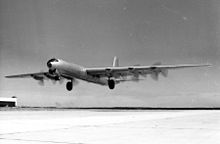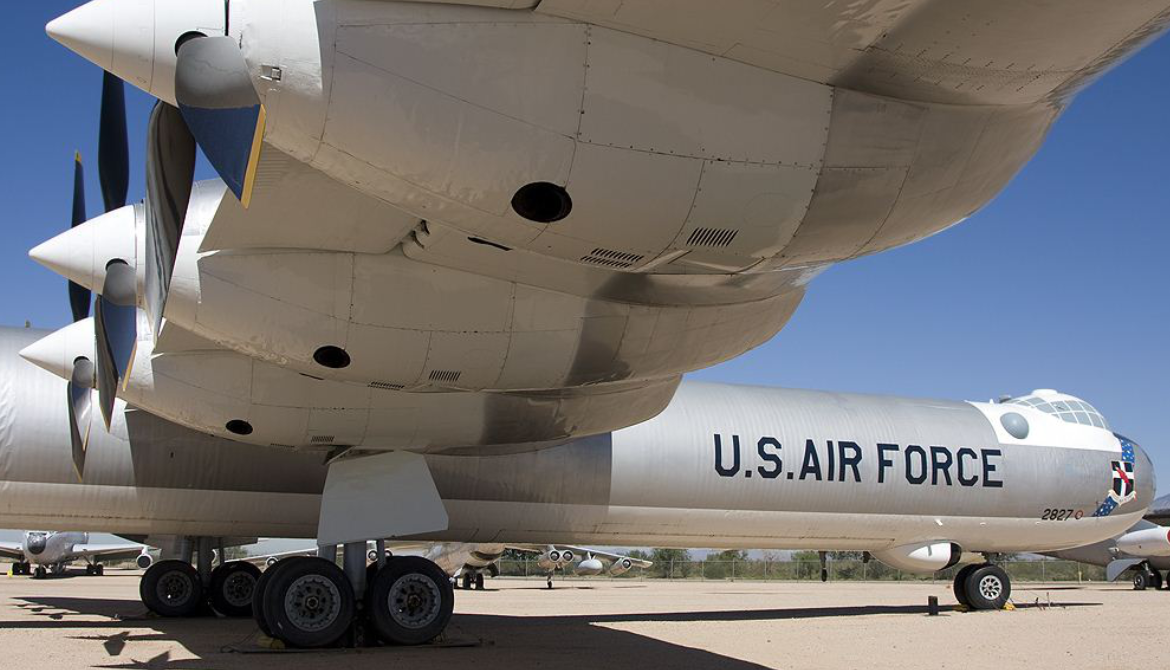Consolidated / Convair B-36 Peacemaker
 |
|
| General information | |
|---|---|
| Type | Strategic bomber |
| National origin | United States |
| Manufacturer | Convair |
| Primary user | United States Air Force |
| Number built | 384 |
| History | |
| Manufactured | 1946–1954 |
| Introduction date | 1948 |
| First flight | 8 August 1946 |
| Retired | 12 February 1959 |
| Variants | Convair XC-99 Convair NB-36H |
| Developed into | Convair YB-60 Convair X-6 |
.
History Consolidated / Convair
Convair B-36 Peacemaker
Manufactured 1946–1954, First flight 8 August 1946

The Convair B-36 "Peacemaker" is a strategic bomber that was built by Convair and operated by the United States Air Force (USAF) from 1949 to 1959. The B-36 is the largest mass-produced piston-engined aircraft ever built. It had the longest wingspan of any combat aircraft ever built, at 230 ft (70 m). The B-36 was the first bomber capable of delivering any of the nuclear weapons in the U.S. arsenal from an internal bomb bay without aircraft modifications
Entering service in 1948, the B-36 was the primary nuclear weapons delivery vehicle of Strategic Air Command (SAC) until it was replaced by the jet-powered Boeing B-52 Stratofortress beginning in 1955. All but four aircraft have been scrapped.
Development

The genesis of the B-36 can be traced to early 1941, prior to the entry of the United States into World War II. At the time, the threat existed that Britain might fall to the German "Blitz", making a strategic bombing effort by the United States Army Air Corps (USAAC) against Germany impossible with the aircraft of the time.
The United States would need a new class of bomber that would reach Europe and return to bases in North America, necessitating a combat range of at least 5,700 miles (9,200 km), the length of a Gander, Newfoundland–Berlin round trip. The USAAC therefore sought a bomber of truly intercontinental range, similar to the German Reichsluftfahrtministerium's (RLM) ultralong-range Amerikabomber program, the subject of a 33-page proposal submitted to Reichsmarschall Hermann Göring on 12 May 1942.
The USAAC sent out the initial request on 11 April 1941, asking for a 450 mph (720 km/h) top speed, a 275 mph (443 km/h) cruising speed, a service ceiling of 45,000 ft (14,000 m)—beyond the range of ground-based anti-aircraft fire—and a maximum range of 12,000 miles (19,000 km) at 25,000 ft (7,600 m). These requirements proved too demanding for any short-term design, far exceeding the technology of the day, so on 19 August 1941, they were reduced to a maximum range of 10,000 mi (16,000 km), an effective combat radius of 4,000 mi (6,400 km) with a 10,000 lb (4,500 kg) bombload, a cruising speed between 240 and 300 mph (390 and 480 km/h), and a service ceiling of 40,000 ft (12,000 m)—above the maximum effective altitude of Nazi Germany's anti-aircraft guns, save for the rarely-deployed 12.8 cm FlaK 40 heavy flak cannon.
0
KmCeiling
0
KmCombat RANGE
0
Km/hAircraft Speed
0
Max Crew
Photo Gallery
Consolidated / Convair / Vultee
Convair B-36 Peacemaker
Manufactured 1946–1954, First flight 8 August 1946


Consolidated Convair Vultee
Convair B-36 Peacemaker
General characteristics
- Crew: 13
- Length: 162 ft 1 in (49.40 m)
- Wingspan: 230 ft 0 in (70.10 m)
- Height: 46 ft 9 in (14.25 m)
- Wing area: 4,772 sq ft (443.3 m2)
Powerplant
- Empty weight: 166,165 lb (75,371 kg)
- Max takeoff weight: 410,000 lb (185,973 kg)
- Powerplant: 6 × Pratt & Whitney R-4360-53 Wasp Major 28-cylinder 4-row air-cooled radial piston engines, 3,800 hp (2,800 kW) each for take-off
- Powerplant: 4 × General Electric J47 turbojet engines, 5,200 lbf (23 kN) thrust each in pylon mounted pods outboard of piston engines
- Propellers: 3-bladed Curtiss Electric constant-speed fully-feathering pusher propellers
Specifications
- Maximum speed: 435 mph (700 km/h
- Cruise speed: 230 mph (370 km/h,
- Combat range: 3,985 mi (6,413 km
- Ferry range: 10,000 mi (16,000 km,)
- Service ceiling: 43,600 ft (13,300 m)
- Rate of climb: 1,995 ft/min (10.13 m/s)
Armament
- Guns: 1 remotely operated tail turret with 2× 20 mm (0.787 in) M24A1 autocannon
- Bombs: 86,000 lb (39,000 kg) with weight restrictions, 72,000 lb (33,000 kg) normal
.
Links to Youtube & Others
As the Pacific war progressed, the USAAF increasingly needed a bomber capable of reaching Japan from its bases in Hawaii, and the development of the B-36 resumed in earnest. Secretary of War.
Convair B-36 Peacemaker
The Convair B-36 "Peacemaker" was a strategic bomber built by Convair and operated solely by the United States Air Force (USAF) from 1949 to 1959.
Youtube Link
The Convair B-36 "Peacemaker" was a strategic bomber built by Convair and operated solely by the United States Air Force (USAF) from 1949 to 1959.












